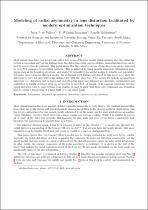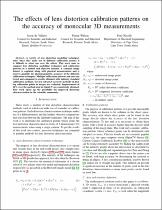 ResearchSpace
ResearchSpace
Modeling of radial asymmetry in lens distortion facilitated by modern optimization techniques
JavaScript is disabled for your browser. Some features of this site may not work without it.
- ResearchSpace
- →
- Research Publications/Outputs
- →
- Conference Publications
- →
- View Item
| dc.contributor.author |
De Villiers, Johan P

|
|
| dc.contributor.author |
Leuschner, FW

|
|
| dc.contributor.author |
Geldenhuys, R

|
|
| dc.date.accessioned | 2010-04-08T12:08:37Z | |
| dc.date.available | 2010-04-08T12:08:37Z | |
| dc.date.issued | 2010-01-18 | |
| dc.identifier.citation | De Villiers, JP; Leuschner, FW and Geldenhuys, R 2009. Modeling of radial asymmetry in lens distortion facilitated by modern optimization techniques. 2010 SPIE/IS&T Electronic Imaging Conference, San Jose, California, 17-21 January 2010, Vol 7539, pp 1-8 | en |
| dc.identifier.uri | http://hdl.handle.net/10204/4014 | |
| dc.description | Copyright: 2009 SPIE. 2010 SPIE/IS&T Electronic Imaging Conference, San Jose, California, 17-21 January 2010 | en |
| dc.description.abstract | Most current lens distortion models use only a few terms of Brown's model, which assumes that the radial distortion is dependant only on the distance from the distortion centre, and an additive tangential distortion can be used to correct lens de-centering. This paper shows that the characterization of lens distortion can be improved by over 79% compared to prevailing methods. This is achieved by using modern numerical optimization techniques such as the Leapfrog algorithm, and sensitivity-normalized parameter scaling to reliably and repeatably determine more terms for Brown's model. An additional novel feature introduced in this paper is to allow the distortion to vary not only with polar distance but with the angle too. Two models for radially asymmetrical distortion (i.e. distortion that is dependant on both polar angle and distance) are discussed, implemented and contrasted to results obtained when no asymmetry is modelled. A sample of 32 cameras exhibiting extreme barrel distortion (due to their 6.0mm focal lengths) is used to show that these new techniques can straighten lines to within 7 hundredths of a pixel RMS over the entire image. | en |
| dc.language.iso | en | en |
| dc.publisher | SPIE | en |
| dc.subject | Distortion correction | en |
| dc.subject | Numerical optimization | en |
| dc.subject | Asymmetry | en |
| dc.subject | Distortion characterization | en |
| dc.subject | Real-time | en |
| dc.subject | Leapfrog algorithm | en |
| dc.subject | Sensitivity normalized parameter | en |
| dc.subject | Brown's model | en |
| dc.subject | Radially asymmetrical distortion | en |
| dc.subject | Lens distortion | en |
| dc.subject | Modern optimization techniques | en |
| dc.title | Modeling of radial asymmetry in lens distortion facilitated by modern optimization techniques | en |
| dc.type | Conference Presentation | en |
| dc.identifier.apacitation | De Villiers, J. P., Leuschner, F., & Geldenhuys, R. (2010). Modeling of radial asymmetry in lens distortion facilitated by modern optimization techniques. SPIE. http://hdl.handle.net/10204/4014 | en_ZA |
| dc.identifier.chicagocitation | De Villiers, Johan P, FW Leuschner, and R Geldenhuys. "Modeling of radial asymmetry in lens distortion facilitated by modern optimization techniques." (2010): http://hdl.handle.net/10204/4014 | en_ZA |
| dc.identifier.vancouvercitation | De Villiers JP, Leuschner F, Geldenhuys R, Modeling of radial asymmetry in lens distortion facilitated by modern optimization techniques; SPIE; 2010. http://hdl.handle.net/10204/4014 . | en_ZA |
| dc.identifier.ris | TY - Conference Presentation AU - De Villiers, Johan P AU - Leuschner, FW AU - Geldenhuys, R AB - Most current lens distortion models use only a few terms of Brown's model, which assumes that the radial distortion is dependant only on the distance from the distortion centre, and an additive tangential distortion can be used to correct lens de-centering. This paper shows that the characterization of lens distortion can be improved by over 79% compared to prevailing methods. This is achieved by using modern numerical optimization techniques such as the Leapfrog algorithm, and sensitivity-normalized parameter scaling to reliably and repeatably determine more terms for Brown's model. An additional novel feature introduced in this paper is to allow the distortion to vary not only with polar distance but with the angle too. Two models for radially asymmetrical distortion (i.e. distortion that is dependant on both polar angle and distance) are discussed, implemented and contrasted to results obtained when no asymmetry is modelled. A sample of 32 cameras exhibiting extreme barrel distortion (due to their 6.0mm focal lengths) is used to show that these new techniques can straighten lines to within 7 hundredths of a pixel RMS over the entire image. DA - 2010-01-18 DB - ResearchSpace DP - CSIR KW - Distortion correction KW - Numerical optimization KW - Asymmetry KW - Distortion characterization KW - Real-time KW - Leapfrog algorithm KW - Sensitivity normalized parameter KW - Brown's model KW - Radially asymmetrical distortion KW - Lens distortion KW - Modern optimization techniques LK - https://researchspace.csir.co.za PY - 2010 T1 - Modeling of radial asymmetry in lens distortion facilitated by modern optimization techniques TI - Modeling of radial asymmetry in lens distortion facilitated by modern optimization techniques UR - http://hdl.handle.net/10204/4014 ER - | en_ZA |








